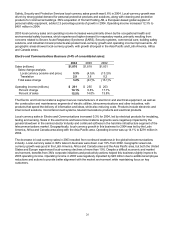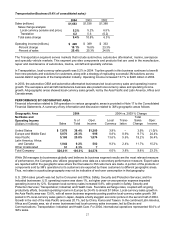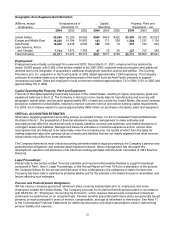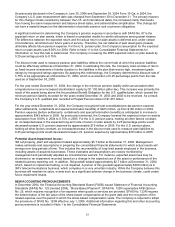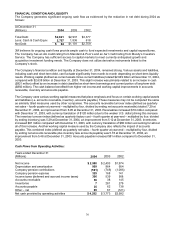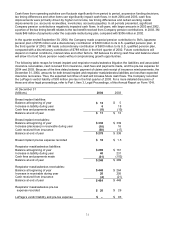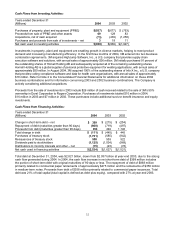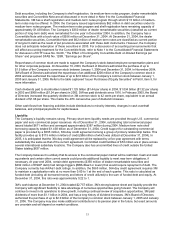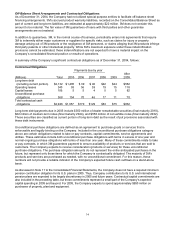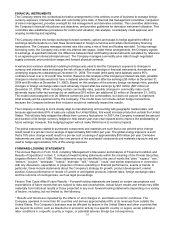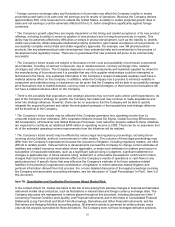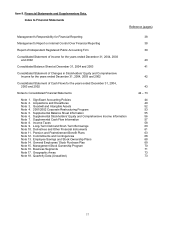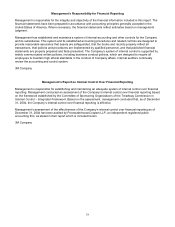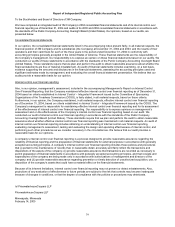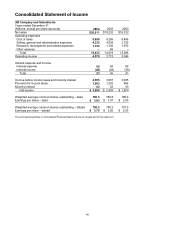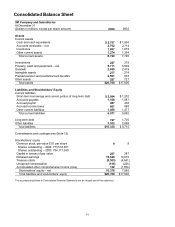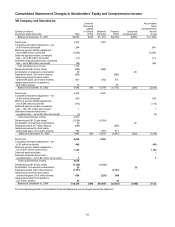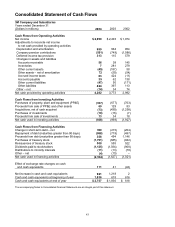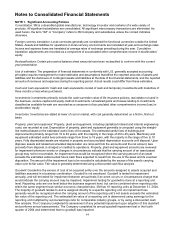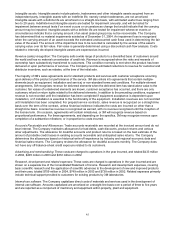3M 2004 Annual Report Download - page 61
Download and view the complete annual report
Please find page 61 of the 2004 3M annual report below. You can navigate through the pages in the report by either clicking on the pages listed below, or by using the keyword search tool below to find specific information within the annual report.35
FINANCIAL INSTRUMENTS
The Company enters into contractual derivative arrangements in the ordinary course of business to manage foreign
currency exposure, interest rate risks and commodity price risks. A financial risk management committee, composed
of senior management, provides oversight for risk management and derivative activities. This committee determines
the Company’s financial risk policies and objectives, and provides guidelines for derivative instrument utilization. This
committee also establishes procedures for control and valuation, risk analysis, counterparty credit approval, and
ongoing monitoring and reporting.
The Company enters into foreign exchange forward contracts, options and swaps to hedge against the effect of
exchange rate fluctuations on cash flows denominated in foreign currencies and certain intercompany financing
transactions. The Company manages interest rate risks using a mix of fixed and floating rate debt. To help manage
borrowing costs, the Company may enter into interest rate swaps. Under these arrangements, the Company agrees
to exchange, at specified intervals, the difference between fixed and floating interest amounts calculated by reference
to an agreed-upon notional principal amount. The Company manages commodity price risks through negotiated
supply contracts, price protection swaps and forward physical contracts.
A variance/co-variance statistical modeling technique was used to test the Company’s exposure to changes in
currency and interest rates and assess the risk of loss in after-tax earnings of financial instruments, derivatives and
underlying exposures outstanding at December 31, 2004. The model (third-party bank dataset) used a 95%
confidence level over a 12-month time horizon. Based on this analysis of the Company’s interest rate risks, possible
changes in interest rates would not have a material adverse effect on after-tax earnings ($5 million at December 31,
2004 and $6 million at December 31, 2003). Based on this analysis of the primary foreign exchange risks, possible
changes in foreign exchange rates could adversely impact after-tax earnings by $61 million ($67 million at
December 31, 2003). When including certain commodity risks, possible changes in commodity rates could
adversely impact after-tax earnings by an additional $10 million (an additional $3 million at December 31, 2003).
The model used analyzed over 20 different currencies and five commodities, but does not purport to represent
what actually will be experienced by the Company. This model does not include certain hedge transactions,
because the Company believes their inclusion would not materially impact the results.
The Company is striving to more closely align its manufacturing and sourcing with geographic market sales, and
because approximately 60% of sales are outside the United States, this would increase production outside the United
States. This will also help mitigate the effects from currency fluctuations. In 2001, the Company increased the amount
and duration of its foreign currency hedges to help lessen year-over-year impacts and to improve the predictability of
future earnings. However, this hedging program will not make 3M immune to currency impacts.
The global exposures related to purchased components and materials are such that a one percent price change
would result in a pre-tax cost or savings of approximately $44 million per year. The global energy exposure is such
that a 10% price change would result in a pre-tax cost or savings of approximately $30 million per year. Derivative
instruments are used to hedge less than one percent of the purchased components and materials exposure and are
used to hedge approximately 10% of this energy exposure.
FORWARD-LOOKING STATEMENTS
This Annual Report on Form 10-K, including “Management’s Discussion and Analysis of Financial Condition and
Results of Operations” in Item 7, contains forward-looking statements within the meaning of the Private Securities
Litigation Reform Act of 1995. These statements may be identified by the use of words like “plan,” “expect,” “aim,”
“believe,” “project,” “anticipate,” “intend,” “estimate,” “will,” “should,” “could” and similar expressions in connection
with any discussion, expectation or projection of future operating or financial performance, events or trends. In
particular, these include statements about the Company’s strategy for growth, product development, market
position, future performance or results of current or anticipated products, interest rates, foreign exchange rates,
and the outcome of contingencies, such as legal proceedings.
Factors That Could Affect Future Results – Forward-looking statements are based on certain assumptions and
expectations of future events that are subject to risks and uncertainties. Actual future results and trends may differ
materially from historical results or those projected in any such forward-looking statements depending on a variety
of factors, including, but not limited to, the following:
* Results and trends are impacted by the effects of, and changes in, worldwide economic conditions. The
Company operates in more than 60 countries and derives approximately 60% of its revenues from outside the
United States. The Company’s business may be affected by factors in the United States and other countries that
are beyond its control, such as downturns in economic activity in a specific country or region; social, political or
labor conditions in a specific country or region; or potential adverse foreign tax consequences.



